EIGRP Tutorial
In this article we will mention about the EIGRP protocol.
In the past, Enhanced Interior Gateway Routing Protocol (EIGRP) is a Cisco-proprietary routing protocol but from March-2013 Cisco opens up EIGRP as an open standard in order to help companies operate in a multi-vendor environment. EIGRP is a classless routing protocol, meaning that it sends the subnet mask of its interfaces in routing updates, which use a complex metric based on bandwidth and delay.
EIGRP is referred to as a hybrid routing protocol because it has the characteristics of both distance-vector and link-state protocols but now Cisco refers it as an advanced distance vector protocol.
Notice: the term “hybrid” is misleading because EIGRP is not a hybrid between distance vector and link-state routing protocols. It is a distance vector routing protocol with enhanced features.
EIGRP is a powerful routing protocol and it is really standout from its ancestor IGRP. The main features are listed below:
+ Support VLSM and discontiguous networks
+ Use Reliable Transport Protocol (RTP) to delivery and reception of EIGRP packets
+ Use the best path selection Diffusing Update Algorithm (DUAL), guaranteeing loop-free paths and backup paths throughout the routing domain
+ Discover neighboring devices using periodic Hello messages to discover and monitor connection status with its neighbors
+ Exchange the full routing table at startup and send partial* triggered updates thereafter (not full updates like distance-vector protocols) and the triggered updates are only sent to routers that need the information. This behavior is different from the link-state protocol in which an update will be sent to all the link-state routers within that area. For example, EIGRP will send updates when a new link comes up or a link becoming unavailable
+ Supports multiple protocols: EIGRP can exchange routes for IPv4, IPv6, AppleTalk and IPX/SPX networks
+ Load balancing: EIGRP supports unequal metric load balancing, which allows administrators to better distribute traffic flow in their networks.
* Notice: The term “partial” means that the update only includes information about the route changes.
EIGRP use metrics composed of bandwidth, delay, reliability, and load. By default, EIGRP uses only bandwidth and delay.
EIGRP use five types of packets to communicate:
+ Hello: used to identify neighbors. They are sent as periodic multicasts
+ Update: used to advertise routes, only sent as multicasts when something is changed
+ Ack: acknowledges receipt of an update. In fact, Ack is Hello packet without data. It is always unicast and uses UDP.
+ Query: used to find alternate paths when all paths to a destination have failed
+ Reply: is sent in response to query packets to instruct the originator not to recompute the route because feasible successors exist. Reply packets are always unicast to the originator of the query
EIGRP sends every Query and Reply message using RTP, so every message is acknowledged using an EIGRP ACK message.
EIGRP Route Discovery
Suppose that our network has 2 routers and they are configured to use EIGRP. Let’s see what will happen when they are turned on.
Firstly, the router will try to establish a neighboring relationships by sending “Hello” packets to others running EIGRP. The destination IP address is 224.0.0.10 which is the multicast address of EIGRP. By this way, other routers running EIGRP will receive and proceed these multicast packets. These packets are sent over TCP.
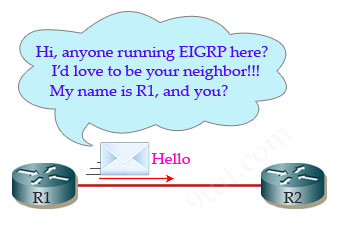
After hearing “Hello” from R1, R2 will respond with another “Hello” packet.

R2 will also send its routing table to R1 by “Update” packets. Remember that R2 will send its complete routing table for the first time.
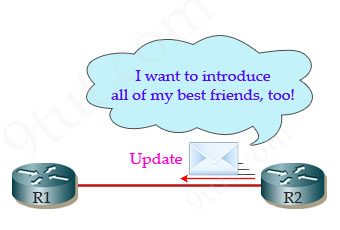
R1 confirms it has received the Update packet by an “ACK” message.
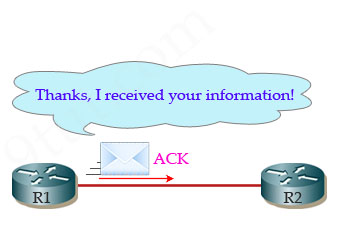
R1 will also send to R2 all of its routing table for the first time
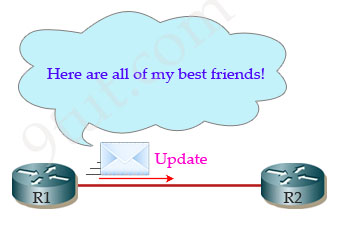
R2 sends a message saying it has received R1′s routing table.
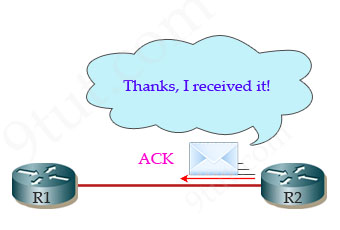
Now both R1 & R2 learn all the paths of the neighbor and the network is converged. But there are some notices you should know:
+ After the network converged, “Hello” messages will still be sent to indicate that the it is still alive.
+ When something in the network changes, routers will only send partial updates to routers which need that information.
+ Hellos are sent as periodic multicasts and are not acknowledged directly.
+ The first hellos are used to build a list of neighbors; thereafter, hellos indicate that the neighbor is still alive
To become a neighbor, the following conditions must be met:
+ The router must hear a Hello packet from a neighbor.
+ The EIGRP autonomous system must be the same.
+ K-values must be the same.
EIGRP builds and maintains three tables:
+ Neighbor table: lists directly connected routers running EIGRP with which this router has an adjacency
+ Topology table: lists all routes learned from each EIGRP neighbor
+ Routing table: lists all best routes from the EIGRP topology table and other routing processes
Configuring EIGRP
| Router(config)#router eigrp 1 |
Syntax: router eigrp <AS number> Turn on the EIGRP process 1 is the Autonomous System (AS) number. It can be from 1 to 65535. All routers in the same network must use the same AS number. |
| Router(config-router)#network 192.168.1.0 |
Router will turn on EIGRP 1 process on all the interfaces belonging to 192.168.1.0/24 network. |
In the next part we will learn about the Feasible Distance & Administrative Distance of EIGRP



this is very gud
and all the information in very dip…
thanku so much
god bless u
really its good for undersatnding the eigrp principle
it helps to configure and depth knowledge and also outlook for basic
really its good for undersatnding the eigrp principle
it helps to configure and depth knowledge and also outlook for basic concepts
Hello,
How to configure Diffreent AS number in EIGRP with Redistribuition
Thanks
Guys thanx i was so confused on EIGRP can you pliz help with Frame relay now
Thanks for the in-depth explanation!
Hie
thanx a million
Was confused in todd lammle…ty 9tut :)
detailed, easy to understand, yah keep it up, thanx….thanx
Thanks 9tut.com.I now have more clear picture of EIGRP.
Much appreciated, thank you guys for all ur time and effort
9tut – Thanks for the overview – concise and to the point… I hope I can retain all of this as pieces of this will be on exam questions…
Very good summary,Many thanks
Very well explained, nice for beginners and good to improve and revise your concepts for existing students. Very good summery of very lengthy topic.
Much appreciated, thank you guys for all ur time and effort
Perhaps add in the default Admin Distance of 90 ? I didnt see that mentioned.
Now a days Cisco is asking some new questions which are not in pass4sure. Is any one has the source for these new questions?
god
good to read this!!!!!!!!!!!!!
Thank you very much,,
G00D WORK INDEED…….!!!!!! THNX
Thank You! This is very useful!
this is great
in which condition , we can use ” no auto-summary” and for what purpose we use them.?
Good One…
Greetings,
Very good. Thank you for your effort .
Thanks again… the tutorial was of immense help. Only I think that the figure for outbound interface in the Routing table should be “e0″ and not 50 which is the AD for Router A to reach D. If I am wrong then please do correct me. Thank you.
Amazing! :)
thanks for this tutorial
Realllllly Thank You! This is very useful! I appreciate u for ur work
Thank You for sharing these clear explanation with us.
Great work
easy to understand..Thanks a lot….
nice 9tut tutorial.
Nice explanation …!!!
Thank You 9tut.com for sharing these clear explanation with us.
Great Work.
Thank you very much
Thanks a million 9tut.I have to take hours to read this in Sybex.
Now this post take me just a few minutes.I really appreciate 9tut.
Hello 9tut,
Can u plz double check the metric formula?
I guess it should be:
metric = [K1 * bandwidth + (K2 * bandwidth)/(256 - load) + K3 * delay] + [K5/(reliability + K4)]
otherwise, the metric will equal to zero if k4 & k5 are zeros!!!
Thx 4 the gr8 info…keep it up
if K4 is 0 then
[K5/(reliability + K4)] = K5/reliability
if K5 is 0 then
[K1 * bandwidth + (K2 * bandwidth)/(256 - load) + K3 * delay] + [K5/(reliability + K4)] =
[K1 * bandwidth + (K2 * bandwidth)/(256 - load) + K3 * delay] + 0 =
[K1 * bandwidth + (K2 * bandwidth)/(256 - load) + K3 * delay]
Really Good !
if I used a class C with /24 instead of a class A (or B) /24, I won’t need no auto-summary right?
@jeff
yeap. you’re wasting the entire address space on one interface with that /24 mask so… no need for “no auto-summary” in that case.
auto-summary is used to have less advertisement packets sent during updates and to keep the routing table less crowded
I’ve been creating these labs for ICND2 and I always use class C /24 so I never used “no auto-summary”.
On page 2 routing table, shouldn’t the metric be Administrative Distance instead of Feasible Distance? By default, EIGRP has an AD of 90 as the table shows on page 3. For the routing table, it is [Administrative Distance (default of 90) / Advertised Distance (from neighboring router to destination)].
@Jeff2: In the routing table, the metric is the Feasible Distance. Notice that the FD from routerA to IOWA is 90 because 90 = 40 (routerA -> IDAHO) + 50 (IDAHO -> IOWA). It is not the AD of EIGRP.
But on the show ip route that you did on page 3, it says [90/30720] on the routing table for every route learned through EIGRP. What is 90 there? 30720 is Advertised Distance.
@xallax
I meant,
In the tutorial the equation is written wrong, there is (*) instead of (+), so in that case the metric will be zero…maybe typo…
could be…
@Jeff2: In [90/30720], 90 is the Adminstrative Distance of EIGRP.
But in your Routing table on page 2, the metric is Feasible Distance not Administrative Distance. When we talk about routing tables, shouldn’t it always be 90 for EIGRP? And it should be [AD of EIGRP / Advertised Distance] for EIGRP. Again, I am asking about the routing table. Like for RIP [AD of RIP (120) / Hop count].